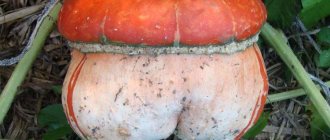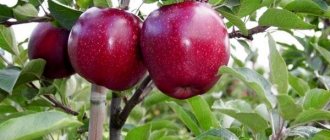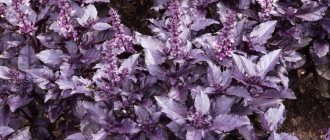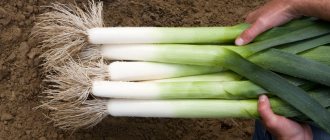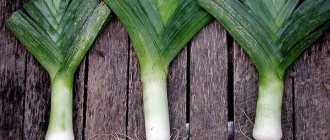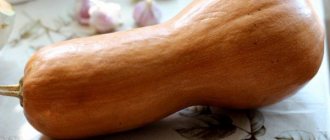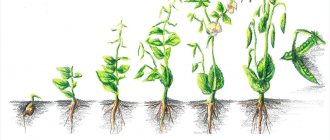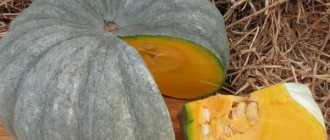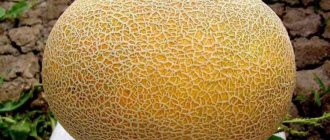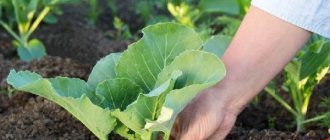Reviews of the most popular varieties
What is the name of a pear-shaped climbing pumpkin? How to fertilize pumpkin patches? Small reviews about the most popular pear-shaped varieties will help answer these questions.
Prikubanskaya
It belongs to the muscat varieties and has a delicate and juicy taste. Prikubanskaya resembles a ripe sweet melon. This variety is mid-season; gardeners harvest it 120-130 days after planting. The bushes are semi-spreading, the length of the vines is about 0.3 m. The pumpkins are elongated, shaped like a thin and long pear. The color is brownish-yellow, with brown spots visible on the surface. The pulp is red-orange, the peel is dense. Prikubanskaya is perfectly stored and transported. Productivity is stable, from 1 sq. m, gardeners collect about 2 kg of ripe and tasty fruits.
The nutmeg variety is used to prepare healthy and dietary dishes. From the fruits you can make puree soup, vegetable stew, vitamin salads and even sweet pastries: muffins, pies, cheesecakes, pancakes. Such tasty and low-calorie dishes are good for the body, saturating it with vitamins A and B, iron, beta-carotene, calcium and magnesium. At the same time, they do not harm the figure, because 100 g of Prikubanskaya contains only 28 kcal.
Pearl
Medium late variety , pumpkin ripens in 130-140 days. It is recommended to plant in the middle zone or in the south of the country. Fertile and sunny beds are ideal for growing. Before planting, the soil is carefully dug up and fertilized with peat. To obtain a rich harvest, summer residents recommend planting the variety in seedlings. To do this, seedlings are prepared a month before planting: soil and seeds are poured into clean containers and placed on the windowsill. Every 10 days, the seedlings are watered with warm water, and once every two weeks they are fed with organic fertilizers, for example, liquid bird droppings.
The average length of the fruit is about 40-50 cm, weight varies from 5 to 7 kg. The peel is thin, there are few seeds. The pulp is crispy and dense, and has a bright yellow color due to its high carotene content. The variety is sweet, so it is consumed both fresh and after heat treatment. The pearl is highly resistant to diseases and insect pests. It stores well for up to 4-5 months.
New
Another pear-shaped representative of muscat varieties ripens within 110-115 days. Novelty is planted after spring frosts. The distance between the bushes should be at least 60-70 cm. Pumpkins are watered every 5-7 days, about 1.5 liters of warm water are used per bush. If the summer is rainy, then the amount of watering is reduced. Fertilize the variety three times per season. Summer residents advise alternating organic matter and mineral fertilizers. Wood ash, Bordeaux mixture, nitrogen-containing preparations, and mineral complexes are used as top dressing.
The average weight of the fruit is 4 kg, length is about 50 cm. Pumpkin has an orange-yellow color, dense flesh and excellent taste. The new product has good transportability and can be stored for up to 6-8 months. As a rule, wooden boxes and dry, ventilated rooms, such as a cellar or basement, are used for storage. The yield is high, about 5 kg per 1 sq. m.
Sugar mace
The hybrid has high immunity to diseases and pests. However, experienced gardeners still pay special attention to preventive measures. To prevent the plant from getting powdery mildew, it is sprayed with whey 2-3 times a season. To protect the crop from aphids, slugs and spider mites, vegetables are fertilized with Bordeaux mixture or copper sulfate solution. These methods not only protect the beds from negative factors, but also improve the taste of the pumpkin.
The nutmeg hybrid Sugar mace is an early ripening hybrid, ripening in 90-100 days from the moment of planting. The fruits are long and curved, at the stage of technical ripeness they are green in color, and then become light beige. The flesh is rich yellow, the aroma is sweet and nutmeg. The weight of the pumpkin varies from 1 to 2 kg. Gardeners value the hybrid for its high yield, from 1 sq. m they collect about 15-20 kg of unusual vegetables.
Pineapple
The hybrid matures in 100-110 days and is suitable for growing in the south of the country . Pineapple has tasty pulp and contains a large amount of vitamins and microelements. The weight of the fetus is about 2 kg. Pumpkin has a light orange color, dense and crispy flesh. It stores well and is often grown on an industrial scale. The product is consumed fresh, boiled, steamed and even fried.
Interesting ! Regular consumption of pumpkin slows down the aging process of the body, improves the quality of skin, hair and nails. In addition to pumpkin pulp, seeds are often used: they contain a high content of copper, zinc and phosphorus.
Butternut
This variety is often called “nut pumpkin”; the taste of the fruit is filled with nutmeg notes. The pear-shaped pumpkin reaches a weight of 1-1.5 kg. It has a dense peel and yellow-orange color. The variety is early ripening, ripens in 2.5-3 months. The vegetable is planted in greenhouses or in the open air. Before planting, seeds, beds and garden tools must be disinfected. When grown by seedlings, seedlings are hardened off.
Description of the variety
Early variety of pumpkin Golden Pear. Technical ripeness of the fruit occurs after 95 days. According to gardeners, the plant is unpretentious, tolerates high soil moisture well, but does not develop well in extreme heat.
She is also afraid of frost. Seedlings and fruits must be protected from low temperatures:
- The Golden Pear pumpkin is distinguished by its teardrop-shaped fruit, similar to a fruit. Hence the name of the culture. The fruits are small, up to 2 kg. Cooks use this variety of pumpkin as a portioned pumpkin. In practice, gardeners get larger vegetables, but it is necessary to form a bush;
- The peel is bright orange, dense. During storage it becomes very hard. The surface is tuberculate, weakly segmented. It is divided into segments by light stripes that reach the middle of the fruit;
- the petiole is massive. In the area of the stalk the pumpkin is stretched;
- the flesh is dense, orange, not very juicy, moderately sweet. The manufacturer indicates that the pumpkin has the taste of roasted chestnuts. It is recommended to use it as a side dish for meat and fish dishes. It is put in vegetable stew. Porridge and desserts are not prepared from it. It won't make pumpkin juice;
- the seeds are small. The seed chamber is medium in size. The core is enclosed in a cream-colored shell;
- The bush is very climbing. The stems are powerful, the leaves have a wide blade, slightly dissected. The main stem reaches a length of 7 m. The side vines grow up to 10-14 m. 3 ovaries are formed on each stem;
- Pumpkin can be stored at room temperature for up to 9 months. It is used not only as a table vegetable, but also for interior decoration.
Reviews from summer residents
Most gardeners prefer to grow beautiful and juicy pear-shaped pumpkins. Many are attracted by the classic orange color and melon aroma. However, sometimes expectations are not met: instead of large and attractive fruits, small and watery pumpkins grow.
Arina, Ufa: “I’ve been growing pear-shaped pumpkins for a long time. My favorites are the Novinka and Zhemchuzhina varieties. They are similar to each other, have juicy and sweet flesh. However, the Novinka variety is more productive. I dry pumpkin seeds and add them to baked goods, and from the pulp I make porridge and sweet jam for the winter.”
Olga, Moscow: “ I prefer only muscat varieties. They have amazing taste and aroma. They can be capricious in their care, but if all agrotechnical rules are followed, no problems arise. I especially like to make vitamin juice with ginger and lemon from them, and also cook porridge for breakfast.”
Milana, Yekaterinburg: “I always plant pumpkins in the greenhouse. I especially love Pineapple. She is easy to care for and rarely gets sick. Before planting, I always disinfect the seeds and prepare the seedlings. I harvest in early September. We eat some right away, and leave the rest for the winter.”
Classification of pumpkin varieties
The genus Cucurbita, which unites numerous varieties of pumpkin, includes 18 species, most of which have no culinary value, and some are used as fodder, ornamental and industrial crops.
The main center of origin and distribution of pumpkin plant species is Central and South America, where these plants were familiar and used by people in ancient times. However, some subspecies originate from the Asian region and Africa. Currently, thanks to the development of connections between countries and continents, gardeners have access to all species diversity, and they can try to grow the most unusual plants on their own plot.
And the most famous cultural food species in the world include:
- large-fruited pumpkin or Cucurbita maxima;
- hard-bark pumpkin or Cucurbita pepo;
- butternut squash or Cucurbita moschata.
At the same time, two types, namely large-fruited and hard-barked pumpkins, are also grown for livestock feed.
One of the large-fruited subspecies is the spectacularly shaped pumpkin shown in the photo, reminiscent of Turkish headdresses and grown as an ornamental crop. But the beloved zucchini and squash, although eaten in the form of greens, are also pumpkins and belong to the species Cucurbita pepo.
With a lot of common features and properties, cultivated types and varieties of pumpkin, as in the photo, have a number of differences in the appearance of the green parts of plants and fruits, as well as in their quality.
If you look at the stems, the large-fruited pumpkin will have an almost rounded cross-section, while the hard-barked pumpkin will have clearly visible edges.
A plant belonging to the species Cucurbita maxima can be recognized by its almost flat leaf blades, while the leaves of the butternut squash have a clearly visible notch in the center. And the leaves of the hard-barked pumpkin are covered with coarse, thorn-like hair.
- The fruits of hard-bark and large-fruited pumpkins most often have a round or elongated shape, and the seeds are located in the middle of the fruit in volumetric cavities.
- In the pear-shaped nutmeg pumpkin, the pulp occupies almost the entire volume of the fruit, and there are very few seeds, and they are located closer to the expanding end.
Pumpkins cultivated in Russia and all over the world can have a climbing or bush form. Moreover, the subgroup of bush pumpkins, as in the photo, includes zucchini, zucchini, and squash, cut from the plant at the age of 6–14 days.
So what is good about this or that type of pumpkin? What are its characteristic features and features? Photos of types and varieties of pumpkin will help you understand all the diversity.
General information and classification
This vegetable crop, also called watermelon, is known among amateur gardeners and in industrial cultivation.
Depending on the thickness of the outer skin, all varieties of pumpkin are divided into 3 groups:
- hard-barked (the fruits are covered with a hard crust with a waxy coating, the shape of the pumpkins is elongated, cylindrical);
- nutmeg (the skin is thin, soft, and the fruits are elongated);
- large-fruited (varieties with soft skin and round pumpkins).
Large-fruited pumpkin is most often grown in home gardens. It produces very large fruits. Hard-barked pumpkin varieties are stored for a long time, but are characterized by small pumpkin sizes. The sweetest varieties belong to the butternut squash category.
All types can be divided into groups depending on their purpose:
- feed pumpkin;
- decorative varieties;
- canteens;
- pumpkin varieties for juice;
- varieties for seeds.
Large-fruited pumpkin (Cucurbita maxima)
The name of this type of pumpkin speaks for itself.
Large-fruited pumpkin varieties are popular among gardeners all over the world, but the most outstanding specimens can only be obtained in long, warm summers. Under favorable conditions, the weight of pumpkins reaches several hundred kilograms, and gourmet varieties accumulate up to 15% sugar.
It is not surprising that the Cucurbita maxima pumpkin species is most widespread in its homeland, Peru, as well as in the southern states of the USA, Bolivia and India, where many interesting local varieties have been obtained. It is interesting that large-fruited pumpkins, even those belonging to the same species, amaze with their shapes, colors and even sizes. Along with giant plants, there are also dwarfs that produce very modest fruits, like the already mentioned turban-shaped pumpkin in the photo.
Hardbark pumpkin (Cucurbita rero)
This type of pumpkin growing wild was once discovered by the Indian tribes of Central America and became one of the most popular, if not iconic, plants in the region.
The annual vegetable plant, now represented by many dozens of varieties and varieties, is grown everywhere from southern Mexico to the central United States. The culture contains both climbing and bush plants, and some of the subspecies are decorative pumpkins, as in the photo, used to decorate the garden and interior.
Cucurbita pepo, as a species, is divided into several independent varieties, including: hard-barked pumpkin, squash and squash.
The hard-barked pumpkin got its name due to the rough, very dense layer of bark that gains strength as the fruits ripen. This is the fastest ripening species in Russian gardens, but pumpkin lovers should note that the pulp of this type of fruit can be quite coarse, so you should choose varieties for cultivation especially carefully. Today, summer residents are offered many interesting hybrids and varieties of pumpkin, among which there are plants of very unusual appearance and properties.
An early ripening hard-bark pumpkin of the “Spaghetti” variety ripens in 65–80 days and during the growing season forms a long-climbing plant with oval fruits of a yellowish or cream color. Pumpkin weight ranges from 800 to 1.5 kg, but the main feature of the variety is hidden under the hard bark. This is a low-juicy pulp that breaks down into separate fibers, the appearance of which gave the name to the variety. The sweetness of this pumpkin, in the photo, is not great, but the variety is loved by vegetarians and adherents of proper nutrition for the opportunity to enjoy unusual vegetable “pasta”.
Amazon is an early ripening variety of pumpkin, the main value of which is its small portioned fruits weighing about one kilogram. The juicy orange pulp of pumpkin is rich in sugar and carotenes, valuable for baby and dietary nutrition. At the same time, the productive variety can be classified as bush pumpkins with short, barely developed vines.
Gymnosperm pumpkin deserves special attention from gardeners. This is a mid-season variety that produces plants with long, powerful vines up to 5 meters long. The weight of one pumpkin is 3–5 kg, the flesh is orange and loose.
A characteristic feature of the culture is oil-rich, tasty seeds without a hard surface shell. The pumpkin in the photo is unpretentious, but it cannot be stored for a long time due to the danger of seeds sprouting inside the fruit.
The ultra-early ripening variety of bush pumpkin “Smile” easily tolerates frost, is productive and is valued as a source of sweet portioned fruits with pulp that smells like real melon.
A typical example of bush pumpkin varieties are squash and zucchini grown in every garden, as well as zucchini, popular today, with fruits of all shades of yellow and green.
Varieties of hard-bark pumpkin
This group also includes zucchini and squash.
- This variety can most often be found in Russian areas.
- Hard-bark varieties are characterized by long plant stems - up to 7 m. They are also called table plants.
- But there are also plants with short stems.
Bun
- Early variety. It takes about 3 months to get the first pumpkins.
- The fruits are small - 1.5 kg, colored orange. White stripes divide it into segments.
- The inside is sugary, juicy, and orange in color.
- The variety is suitable for storage. The harvested crop can be consumed fresh, used for making juices, dietary dishes, etc.
Gymnosperm
- Gymnosperm pumpkin is a group of plants whose seeds are not covered with a hard shell. This variety was known at the beginning of the 20th century, but nowadays it has begun to gain popularity again.
- Externally, the fruits are not particularly attractive - they are green and yellow in color. The outside is covered with a dense, hard, but thin peel. Round in shape, with barely noticeable ribbing, weighing 3-7 kg.
- The first harvest is harvested 4 months after emergence. The shelf life of the fruit is about 2 months.
- The pulp is used both in raw form and for preparing various dishes, as well as in cosmetology and medicine. Some sources say the best time to use pumpkins is a few weeks after picking. At this point they reveal their full taste.
- Most often, this variety is grown specifically for seeds. Representatives of gymnosperms are recommended to be planted away from other pumpkin vegetables, as they can cross-pollinate. In this case, the seed will already have a dense shell.
The most famous varieties of gymnosperm pumpkin:
Butternut squash (Cucurbita moschata)
Butternut squash can easily be called the most delicious of all cultivated species. It is not surprising that the seeds of this particular culture were found by archaeologists during the study of ancient settlements in South America.
According to morphological characteristics, namely the appearance of stems, leaves and flowers, this type of pumpkin occupies an intermediate position between Cucurbita maxima and Cucurbita pepo. But the fruit pulp is strikingly different in appearance and taste, because on average it contains up to 11.5% sugar, is dense, oily and has a subtle pleasant smell.
True, it is more difficult to grow nutmeg pumpkin fruits than large-fruited or hard-barked ones. Plants are demanding of heat and humidity, and pumpkin varieties are mid- or late-season. There are six subspecies of butternut squash in the world. But the most popular are pear-shaped pumpkins, called “butternut” due to the taste and consistency of the pulp.
For Russian summer residents, breeders offer fairly cold-resistant varieties of pumpkin of this type, which bear sweet, delicious fruits in 90–120 days.
An early-ripening variety of nutmeg pumpkin, “Sugar Mace,” forms climbing plants that can simultaneously ripen up to 8 fruits weighing from one and a half to two kilograms.
The peculiarity of the pumpkin variety, as in the photo, is the unusual shape of the fruits and their fairly rapid ripening. Sweet and juicy pulp, rich in carotene, vitamins and can be used for making juices, baby food and other types of culinary processing
Pumpkin variety "Pearl" ripens three weeks later. The fruits in this case have the classic shape of a pear-shaped pumpkin and reach 3–6 kg in weight. The rich orange pulp contains a lot of sugar and carotene, which makes it suitable for baby and medical nutrition. The plants tolerate dry periods well, and the fruits can ripen indoors.
“Pineapple” nutmeg pumpkin is a mid-season hybrid with long vines and pear-shaped delicious fruits weighing up to 2.5 kg. The bark of this variety of pumpkins, as in the photo, has a cream or yellowish tint, and the pulp can accumulate up to 10% sugar. Butternut squash is versatile and disease resistant.
Pear-shaped pumpkin: description of fruits
Long Pear-shaped pumpkin: photo
The fruits of the decorative pear-shaped pumpkin have an unusual shape, which is why they are called pear-shaped. There are some differences between the varieties, but they all differ in their characteristic shape. As a rule, stores sell seed sets containing different varieties of this species.
Today there are about a dozen varieties of pear-shaped pumpkin. From one seed, 20 to 30 fruits are obtained. The color of the fruit can also be different: orange, red, yellow, cream. May have stripes or spots. Varieties of varieties may be smooth or pimply to the touch. The pear shape is also different for everyone. Cobra variety is somewhat elongated in the thin part, the Korona variety has a star-shaped lower part, the Sweet dumping has a segmented lower part of the fruit. The most classic variety is Bottle Leginaria . There are a lot of varieties with curved thin parts of the fruit ( Native, Swan Neck, Peanut Butter ).
It must be said that all varieties of oblong pear-shaped pumpkin are very mediocre in taste, the peel is very dense, and there is almost no pulp or they are not at all juicy, you can eat, nothing bad will happen to you, but it is unlikely to be tasty. Basically, these plants are more decorative in nature, or are used as a basis for various crafts. Handmade lovers will appreciate these unusually shaped fruits, because they can be used to create very unusual crafts. However, there are varieties that are quite suitable for consumption. For example, Peanut variety or Baby boo. The latter received this name because of its unusually small fruits; some experienced gardeners even grow this variety at home. The Sweet Dumping variety is suitable for consumption, but it must be picked when it is not yet ripe, otherwise the fruit will harden.
Figleaf pumpkin (Cucurbita ficifolia)
The Peruvian jungle is home to another type of pumpkin, which, unlike the plants already described, is a perennial crop.
Externally, a green pumpkin, on the surface of which a whitish fancy pattern is clearly visible, when cut, looks more like an unripe watermelon. The oval or elongated fruit of the figleaf pumpkin has rough white or yellowish flesh with a sweetish aroma and taste. The seeds also resemble watermelon in both shape and hard black shell. The plants are vigorous, climbing, individual shoots reach 10 meters in length.
Wax gourd (Benincasa hispida)
Elongated green pumpkins of this species were originally known only in the Southeast. But today the first varieties of pumpkin of the genus Benincasa hispida have appeared in Russia. The fruits are dark green in color and have an unusual dense bark that feels like wax.
The Chengzhou wax gourd variety produces fruits that are ready for harvest 125-130 days after sowing. Pumpkins ripen on long powerful vines. The weight of each fruit reaches 6–15 kg, and its length ranges from 25 to 50 cm.
The milky pulp of this type of pumpkin can be used boiled, stewed or fried. Both green pumpkins that have not reached ripeness and ripe fruits are used for culinary purposes. As the pumpkin ripens, it accumulates some sugar, but it cannot compare with butternut squash. But wax pumpkin holds the record for shelf life. Without loss of quality, fruits can last up to 2–3 years.
Useful tips for choosing a pumpkin - video
Pear shaped pumpkin name
Pumpkin is one of the most popular and affordable autumn products. It first came to us from the USA around the 16th century. Indians roasted long pumpkin slices over open fires and used the fruit as a staple food for centuries. Later, humanity began to use it to prepare side dishes, desserts, soups and even beer!
But first you need to buy a pumpkin. According to various sources, there are from 21 to 27 types of pumpkin, and each of these types has many subspecies. All varieties can be divided into three: decorative, fodder and table. Fodder is most often used for feeding livestock, but canteens are suitable for human food.
Common pumpkin. This is the variety that is usually meant when people talk about pumpkin. It is usually large, round, with a bright orange peel and a mild sweetish taste. Its weight can reach 25 kilograms, but it is recommended to buy a fruit weighing no more than five kilograms. Moreover, the smaller the volume, the sweeter the pumpkin and the less coarse fibers.
Butternut or nutmeg pumpkin. This pumpkin is pear-shaped. It is very aromatic, the skin is smooth yellow-brown, and the flesh is juicy, sweet, deep orange. Thanks to its small size and less fibrous pulp, this pumpkin is very easy to cook.
Acorn pumpkin. A small round pumpkin looks like an acorn, hence the name of the variety - acorn. This species has a thick, dark green skin with deep grooves, sometimes with yellow dots on the skin. The pulp is dense, orange-yellow and sweet. Most often, the fruits of this variety are stuffed or baked.
Pumpkin "Harlequin" . A small, flattened pumpkin with deep furrows and mottled orange-green skin. Its flesh is firm and pale orange and has a delicate sweet taste.
Pumpkin "Chayote", or "Christophine". The color of this pumpkin is pale green and the shape is pear-shaped. Its seeds are large, and the pulp tastes like apples.
Spaghetti pumpkin. This pumpkin is shaped like a melon and has golden yellow flesh inside. When boiled or fried, the pumpkin pulp breaks down into fibers; the similarity of the fibers to spaghetti gives the pumpkin its name. It is better to choose fruits with pale yellow skin; a greenish color on the surface of the pumpkin indicates its immaturity.
Pumpkin "Kherson" . This pumpkin has flat, gray fruits, with light gray stripes and spots on the background, the entire surface is smooth. The peel is elastic. The pulp is orange in color and the taste of this pumpkin is juicy and sweet.
Another popular variety is Altair pumpkin . The fruits are flat-shaped, light gray to dark gray in color, sometimes fruits with pink stripes and spots appear. The pulp is yellow, thick, juicy, sweet.
Pumpkin varieties are divided into winter ones - those that are eaten when ripe, and summer ones - unripe ones. Winter squash always have firm flesh and skin, and are best suited for pie fillings and baking. Summer ones are usually used for boiling, frying and stewing, because their flesh and skin are quite soft. There are also varieties of pumpkins that can be eaten raw.
By the way, pumpkins are best consumed raw; they retain all their beneficial properties better. If you come to the market or store to buy a good pumpkin, but don’t yet know what you will cook from it, you need to know a few features. What should the perfect pumpkin look like?
Its shape should be round or oval. Large pumpkins, although they look impressive, most often turn out to be too dry or, on the contrary, watery, and their taste is bitter. The optimal weight of a pumpkin is 3 – 5 kilograms, no more! But you shouldn’t choose a pumpkin “by eye”; you should always use a scale. Good mature pumpkins can weigh more than they appear at first glance. The color of the pumpkin pulp should be deep yellow or even orange, this depends on the amount of vitamin A it contains - the more it contains, the more saturated the color. In this case, the peel should be dense, but not “wooden”!
And most importantly, remember, a good pumpkin is good both inside and out!
Types of pumpkins
There are three varieties of pumpkins found on farms, fields and gardens around the world:
In each of these varieties there are bush and climbing pumpkins, portioned and with large fruits, with very sweet pulp or a large number of seeds, table, fodder or decorative.
The choice of variety depends on the preferences and goals of the gardener. For those who want to enjoy boiled, stewed or fried pumpkin in the summer, having prepared only the seeds for the winter, it is better to plant more hard-barked summer varieties.
Fans of baked fruits and pumpkin juice are advised to choose nutmeg and large-fruited varieties in order to preserve the fruits until spring. Connoisseurs of fresh salads with pumpkin will like the gray-fruited varieties with sweet pulp.
Varieties of hard-bark pumpkin
This type of pumpkin owes its name to its very thick, woody skin when ripe. Hard-bark pumpkins are distinguished by early ripening (late August-early September), small fruit size and the most delicious seeds. The bush varieties found among this variety of pumpkins are very convenient for saving space.
Hard-barked varieties have a ribbed stalk with pronounced grooves, a spiny hairy stem and pentagonal leaves. The cream-colored seeds have pronounced rims.
Altai
A productive, early-ripening, cold-resistant variety for universal use. The round, orange, ribbed fruits with yellow spots can weigh from 2.5 to 5 kg. The yellow, fibrous pulp does not taste very sweet. The fruits have a high shelf life.
Acorn
Due to the external similarity of small fruits to acorns, this pumpkin is called “acorn” pumpkin. The outer skin of the fruit can range in color from dark green to orange. The yellow-orange flesh has a sweet taste.
Aport
A mid-season bush pumpkin of almost round shape with an orange peel without a pattern and fruits growing up to 7 kg. The pulp is orange-yellow, crispy, juicy. The taste is sweet, with pronounced creamy notes.
Gymnosperm
A mid-ripening variety with pear-shaped or spherical fruits of dark green or yellow mesh green color with orange-yellow tender sweet pulp. It is valued primarily for its fleshy, large, skinless seeds with a high oil content.
Smile
An early ripening variety with small neat bushes that ripens in 85 days. One plant produces 7-8, and sometimes up to 15, small bright orange pumpkins with light stripes with an average weight of about 1.5 kg.
Beautiful flowers and good keeping quality are the characteristic features of this variety. The fruits can last until January at room temperature without losing their flavor. The pulp is 3-4 cm thick, aromatic, crispy, sweet.
Spaghetti
A variety with a “telling” name, the pulp of which disintegrates during cooking into fibers reminiscent of spaghetti. The shape and color of the fruits are similar to melon. Unripe pumpkins are greenish in color; fully ripe ones turn light yellow.
Freckle
An early-ripening bush variety with small fruits weighing up to 3 kg with a light green peel with light spots. The flesh is yellow-orange, with a sweet, delicate flavor and a pear-like flavor. The variety loves good watering, is productive, and stores well.
Kustovaya Gribovskaya 189
An early ripening variety that produces the first harvest in 98 days. The elongated oval fruits with light orange skin with black and dark green spots weigh about 4 kg. The pulp is orange, with excellent taste.
Dacha
The variety is mid-season, the fruits are orange-green, oval, reaching a weight of 4.5 kg. The bright orange pulp is tender, juicy, and has a great taste and vanilla aroma. The variety can be grown in all regions, obtaining high yields. Taste is preserved for 4 months after collection.
Bush orange
A short-climbing, early-ripening plant with compactly growing bushes. Orange large fruits reach a weight of 5 kg. The orange pulp, up to 7 cm thick, has an excellent taste. Pumpkin is unpretentious to growing conditions and tolerates drought well. It can be stored for a long time without losing its taste.
Almond
A mid-season variety of universal use with long vines and round orange fruits weighing 4-5 kg. The orange-yellow crispy juicy flesh has a sweet taste. The fruits are stored for a long time and are great for baby food and making juices.
Mozoleevskaya
A mid-early climbing pumpkin with yellow, egg-shaped fruits with dark green stripes, with an average weight of 4-5 kg. The pale orange dense pulp tastes quite sweet (sugar content reaches 6-7%). The variety is characterized by high keeping quality and good transportability.
Varieties of large-fruited pumpkin
Large-fruited pumpkins are distinguished by the largest size and sweetness of the fruits. Some varieties have a sugar content of about 15%, far exceeding the sweetest watermelon.
Large-fruited varieties are characterized by rounded cylindrical stalks, kidney-shaped or close to pentagonal leaves, and rounded stems without furrows. Large-fruited pumpkins may have dull, milky white or brown seeds. This variety tolerates low temperatures better than others and can be stored for a very long time in an ordinary apartment.
These are mainly unpretentious cold-resistant varieties with large fruits, the weight of some of them can reach 100 kg.
Arina
An unpretentious, disease-resistant early climbing table variety with rounded light gray smooth or slightly segmented fruits with an average weight of 3-5 kg. The yellow, dense pulp has a sweet taste. Stores well and for a long time. The seeds have a high oil content.
Roll
An early universal bush variety with spherical gray slightly segmented fruits weighing about 10 kg. The pulp is juicy, yellow, not very sweet. Mainly grown for its oil-rich seeds.
Big Moon
An unpretentious mid-late variety with powerful vines up to 3 m long. Very large, slightly segmented or smooth yellow fruits weigh 15-40 kg (some can reach 90 kg). The yellow-orange juicy and dense pulp has a good taste.
Zorka
An extra-early large-fruited table variety with long powerful vines. Dark gray fruits with orange spots reach a weight of 5-6 kg. The dense, bright orange pulp contains 12-14% sugar. The value of the variety lies in its exceptional sweetness and high carotene content. The fruits are used to prepare baby food.
Russian
A climbing, early-ripening pumpkin weighing 3-4 kg, resembling a bright orange top in shape. The sweet orange flesh has a delicate melon flavor. The variety is cold-resistant, high-yielding.
Ordinary
The most common variety, the fruits of which can weigh about 25 kg. Smaller pumpkins are sweeter and tastier.
Gribovskaya winter
Late-ripening variety, ripening in 140 days. The plant is long-climbing, with flattened gray fruits weighing more than 3 kg. The pulp is reddish or bright yellow, up to 6 cm thick, dense, tender, juicy, sweet. Stored well.
Children's delicatessen
A productive mid-season table variety with small round (up to 3 kg) orange fruits with green stripes. The pulp is dense, pale orange, sweet, juicy. The fruits have excellent taste. Can be eaten fresh.
Amazon
An early-ripening variety with high taste qualities, with short (no more than 1 m) vines and portioned, slightly flattened orange fruits with light stripes. The crisp, bright orange pulp has a high content of carotene and sugar. Suitable for long-term storage. Can be eaten fresh.
